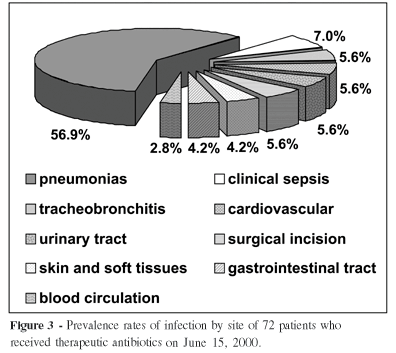OBJECTIVE: To determine the prevalence rates of infections among intensive care unit patients, the predominant infecting organisms, and their resistance patterns. To identify the related factors for intensive care unit-acquired infection and mortality rates. DESIGN: A 1-day point-prevalence study. SETTING:A total of 19 intensive care units at the Hospital das Clínicas - University of São Paulo, School of Medicine (HC-FMUSP), a teaching and tertiary hospital, were eligible to participate in the study. PATIENTS: All patients over 16 years old occupying an intensive care unit bed over a 24-hour period. The 19 intensive care unit s provided 126 patient case reports. MAIN OUTCOME MEASURES: Rates of infection, antimicrobial use, microbiological isolates resistance patterns, potential related factors for intensive care unit-acquired infection, and death rates. RESULTS: A total of 126 patients were studied. Eighty-seven patients (69%) received antimicrobials on the day of study, 72 (57%) for treatment, and 15 (12%) for prophylaxis. Community-acquired infection occurred in 15 patients (20.8%), non- intensive care unit nosocomial infection in 24 (33.3%), and intensive care unit-acquired infection in 22 patients (30.6%). Eleven patients (15.3%) had no defined type. The most frequently reported infections were respiratory (58.5%). The most frequently isolated bacteria were Enterobacteriaceae (33.8%), Pseudomonas aeruginosa (26.4%), and Staphylococcus aureus (16.9%; [100% resistant to methicillin]). Multivariate regression analysis revealed 3 risk factors for intensive care unit-acquired infection: age > 60 years (p = 0.007), use of a nasogastric tube (p = 0.017), and postoperative status (p = 0.017). At the end of 4 weeks, overall mortality was 28.8%. Patients with infection had a mortality rate of 34.7%. There was no difference between mortality rates for infected and noninfected patients (p=0.088). CONCLUSION: The rate of nosocomial infection is high in intensive care unit patients, especially for respiratory infections. The predominant bacteria were Enterobacteriaceae, Pseudomonas aeruginosa, and Staphylococcus aureus (resistant organisms). Factors such as nasogastric intubation, postoperative status, and age ³60 years were significantly associated with infection. This study documents the clinical impression that prevalence rates of intensive care unit-acquired infections are high and suggests that preventive measures are important for reducing the occurrence of infection in critically ill patients.
Intensive care unit; Nosocomial infection; Prevalence rate




